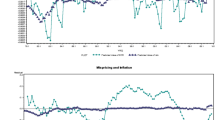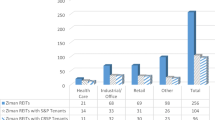Abstract
This paper addresses several issues related to the production of information across commercial real estate markets. The purpose is to determine the extent to which factors of production might complement or substitute for one another. A simple model is presented to illustrate the potential trade-offs between appraisal- and transactions-based information production. A series of empirical tests are performed on a panel data set constructed for 51 markets covering 9 years, 2001 through 2009. The number of commercial appraisers (i.e., certified general appraisers) and the number of commercial property transactions are used as proxies for information production. Overall, the results support the substitution hypothesis. Additional analyses examine a broader definition of appraisal-based information production, as well as the influence of market transparency on the main findings of this paper. Findings based on these additional analyses indicate that the trade-off between appraisal- and transactions-based information production is more pronounced in transparent markets. We conclude that appraisal-based information as a factor of production is, potentially, most critical in markets or conditions where the information environment is incomplete (i.e., transactions are scarce or the information regarding transactions is not public).
Similar content being viewed by others
Notes
See Brennan and Subrahmanyam (1995) for an example in other market settings. See Downs and Güner (1999) for a specific example of information production and its impact on returns for the publicly traded real estate market. Brennan and Subrahmanyam (1995), Downs and Güner (1999) and many others, follow Bhushan (1989) in using the number of financial analysts following a stock as an imperfect proxy for information production. We contend that the number of appraisers following a commercial real estate market is no less justifiable as an imperfect proxy for information production than the number of financial analysts used throughout the equity market literature. Several issues related to this argument are discussed throughout the text.
The approach we use to investigate the relation between appraisal- and transactions-based information production is analogous to a model introduced by Ang and Peterson (1984) and adopted by many others.
There are some fundamental issues regarding the appraisal process and whether appraisers produce “new and relevant” information. Some of these issues bear repeating and others are beyond the scope of the current study. Appraisers gather and produce a wide variety of information and combine this with their expertise to disseminate information on property values. Different parties, i.e., buyers and sellers, lenders, mortgage brokers and insurance companies, utilize the services of appraisers, benefit from the economic value of this information and, theoretically, make better decisions based on this information than they would otherwise. In this context, an appraisal is intended to provide an unbiased estimate (or opinion) of the value of an identified interest in real estate property to all interested parties. At the same time, it is important to recognize that appraisers operate in markets with asymmetric information wherein all the associated issues of principal-agent problems are evident. Cole et al. (1986), Hendershott and Kane (1995), and others address the challenges and conflicts that arise for consumers of CRE appraisal-based information.
We rely on the notion of a unit of information in the same context as Stigler (1961). Furthermore, the following discussion and framework can be adapted to consider \( {\mathbb{Z}_{{(Other Sources)}}} \). In this case, other sources of CRE information would be included on both sides of the Eq. 1 identity. This variable can also be included in subsequent equations in which case it would drop out. Alternatively, other information can be defined as non-overlapping or orthogonal to the two principal sources of information in this framework so it is not going to have any effect on the relation between the two principal sources of information analyzed in this paper.
The information proxies used in this study are, admittedly, rudimentary. Of particular concern is the argument that the number of appraisers in a given state proxies for appraisal-based information production. Unfortunately, we simply do not have a better proxy. In our correspondence with researchers at the Appraisal Institute, they note that there appear to be “no reliable data on appraisal production in the U.S.”
The data that we assembled in this project differ somewhat from the summary data presented by the ASC. This difference is attributed to the fact that we control for duplicate records within a state whereas ASC does not.
While all states have certified general and certified residential appraisers, many states have other classifications of licensure and status. The important point is that all states (implicitly the District of Columbia is included in all states), have provisions for certified general and certified residential appraisers. The principal difference between the two designations is the size and complexity of the permissible valuation assignment, and the required education and experience.
Damodaran and Liu (1993) describe their transaction information scoring process as arbitrary where, in fact, it may more aptly be described as subjective based on weightings. For instance, the authors assign a score of zero to a state if no transaction information is publicly available. A score of .40 is assigned if transaction price is a matter of public record and a score of .50 if state regulations require the buyer and/or seller to sign an affidavit verifying the transaction price. A perfect score of 1.00 is assigned if the preceding conditions are met (i.e., a signed affidavit for the transaction price) and mortgage terms are accessible. While 34 states require disclosure of transaction price in some form or another, only 4 states earn perfect scores. The current paper employs this data to expand the information set \( \mathbb{Z} \) or, analogously, to partition CRE markets according to market transparency.
To account for omitted and unobservable variables, state and time fixed effects are included in our models. In accounting for the state fixed effects, Montana, North and South Dakota, Vermont and Wyoming, the states with no transactions in at least 1 year during the sample period analyzed in this paper, are treated similarly and a single state variable is created for these states. Therefore, even though our data include 51 states, only 46 state fixed effects are used in the estimation process. The base case is for the year 2001 and the five states listed above.
We gratefully acknowledge the suggestion of our referees regarding a more complete treatment of DL-score as a control variable.
Since GDP_GR does not have a statistically significant coefficient in any of the models reported in Table 3, some additional analyses are conducted by removing GDP_GR from the set of control variables. Interestingly, the statistical significance improves considerably for the coefficient estimates of #Trans in the High Market Information column. These results are available upon request. The full model is reported here to preserve consistency across Tables.
References
Ang, J., & Peterson, P. P. (1984). The Leasing Puzzle. The Journal of Finance, 39(4), 1055–1065.
Brennan, M., & Subrahmanyam, A. (1995). Investment analysis and price formation in securities markets. Journal of Financial Economics, 38(3), 361–381.
Bhushan, R. (1989). Firm characteristics and analyst following. Journal of Accounting and Economics, 11(2/3), 255–274.
Cole, R., Guilkey, D., & Miles, M. (1986). Towards an assessment of reliability of commercial appraisals. The Appraisal Journal, 54(3), 422–432.
Damodaran, A., & Liu, C. (1993). Insider trading as a signal of private information. The Review of Financial Studies, 6(1), 79–119.
Downs, D. H., & Güner, Z. N. (1999). Is the Information deficiency in real estate evident in public market trading? Real Estate Economics, 27(3), 517–541.
Downs, D. H., & Güner, Z. N. (2010). Information Producers and Valuation: Evidence from Real Estate Markets. The Journal of Real Estate Finance and Economics, Forthcoming.
Downs, D. H., & Slade, B. (1999). Characteristics of a full-disclosure, transaction-based index of commercial real estate. Journal of Real Estate Portfolio Management, 5(1), 95–104.
Fisher, J., Geltner, D., & Pollakowski, H. (2007). A quarterly transactions-based index of institutional real estate investment performance and movements in supply and demand. Journal of Real Estate Finance and Economics, 34(1), 5–33.
Garmaise, M. J., & Moskowitz, T. J. (2004). Confronting information asymmetries: evidence from real estate markets. Review of Financial Studies, 17(2), 405–437.
Hendershott, P. H., & Kane, E. J. (1995). Office market values during the past decade: how distorted have appraisals been? Real Estate Economics, 23(2), 101–116.
Stigler, G. J. (1961). The economics of information. The Journal of Political Economy, 69(3), 213–225.
Webb, R. B., Miles, M., & Guilkey, D. K. (1992). Transactions-driven commercial real estate returns: the panacea to asset allocation models? Real Estate Economics (formerly, AREUEA Journal), 20(2), 325–357.
Acknowledgements
The authors gratefully acknowledge the research assistance of Kriroek Hemkamon and Ernest O’Boyle. We thank Bob White, Real Capital Analytics, for providing the transactions data and Cristian Tiu for comments on an earlier draft. We are especially grateful to Dean Gatzlaff our discussant at the 2010 Maastricht-NUS-MIT (MNM) Symposium, the editors and an anonymous referee. Downs thanks The Kornblau Institute for support.
Author information
Authors and Affiliations
Corresponding author
Rights and permissions
About this article
Cite this article
Downs, D.H., Güner, Z.N. Commercial Real Estate, Information Production and Market Activity. J Real Estate Finan Econ 46, 282–298 (2013). https://doi.org/10.1007/s11146-011-9348-6
Published:
Issue Date:
DOI: https://doi.org/10.1007/s11146-011-9348-6




